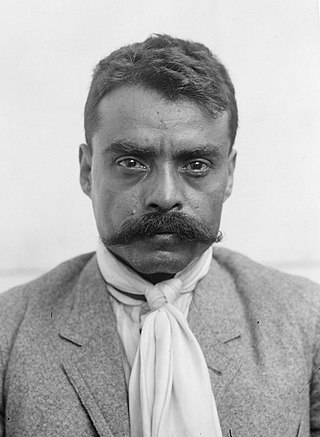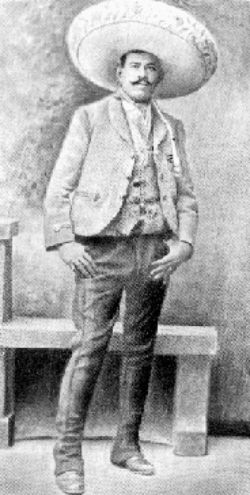Related Research Articles

Emiliano Zapata Salazar was a Mexican revolutionary. He was a leading figure in the Mexican Revolution of 1910–1920, the main leader of the people's revolution in the Mexican state of Morelos, and the inspiration of the agrarian movement called Zapatismo.

Morelos, officially the Free and Sovereign State of Morelos, is one of the 32 states which comprise the Federal Entities of Mexico. It is divided into 36 municipalities and its capital city is Cuernavaca.
Zapata: el sueño del héroe, also titled simply Zapata, is a 2004 Mexican film.
Ciudad Ayala is a city in the east-central part of the Mexican state of Morelos. It stands at 18°45′59″N98°59′05″W, at a mean height of 1,220 m (4,000 ft) above sea level. The city is named for Coronel Francisco Ayala (1760-1812) who fought with José María Morelos during the 1812 Siege of Cuautla. The town's previous name was Mapachtlan. Ayala became a municipality on April 17, 1869.

Cuautla, officially La heroica e histórica Cuautla, Morelos or H. H. Cuautla, Morelos, is a city and municipality in the Mexican state of Morelos, about 104 kilometers south of Mexico City. In the 2010 census the city population was 154,358. The municipality covers 153.651 km2 (59.325 sq mi). Cuautla is the third most populous city in the state, after Cuernavaca and Jiutepec. The city was founded on April 4, 1829. The 2020 population figures were 187,118 inhabitants for the municipality and 157,336 inhabitants for the city of Cuatula.
Emiliano Zapata is a city in the west-central part of the Mexican state of Morelos. It stands at 18°52′N99°09′W. The city serves as the county seat for the surrounding municipality of the same name. The municipality is the sixth largest in the state of Morelos, with a 2020 census population of 107,053 inhabitants, and has it an area of 64.983 km2. The city of Emiliano Zapata had 64,084 inhabitants in 2020. The city was previously known as both San Francisco Zacualpan and San Vicente Zacualpan. It was renamed in honor of Mexican Revolutionary Emiliano Zapata.
Jiutepec is a city and its surrounding municipality in the Mexican state of Morelos.
Tlaltizapán de Zapata is a city in the Mexican state of Morelos. It stands at 18°4′N99°07′W.

The Plan of Ayala was a document drafted by revolutionary leader Emiliano Zapata during the Mexican Revolution. In it, Zapata denounced President Francisco Madero for his perceived betrayal of the revolutionary ideals embodied in Madero's Plan de San Luis Potosí, and set out his vision of land reform. The Plan was first proclaimed on November 28, 1911 in the town of Ayala, Morelos, and was later amended on June 19, 1914. The Plan of Ayala was a key document during the revolution and influenced land reform in Mexico during the 1920s and 1930s. It was the fundamental text of the Zapatistas.

The Liberation Army of the South was a guerrilla force led for most of its existence by Emiliano Zapata that took part in the Mexican Revolution from 1911 to 1920. During that time, the Zapatistas fought against the national governments of Porfirio Díaz, Francisco Madero, Victoriano Huerta, and Venustiano Carranza. Their goal was rural land reform, specifically reclaiming communal lands stolen by hacendados in the period before the revolution. Although rarely active outside their base in Morelos, they allied with Pancho Villa to support the Conventionists against the Carrancistas. After Villa's defeat, the Zapatistas remained in open rebellion. It was only after Zapata's 1919 assassination and the overthrow of the Carranza government that Zapata's successor, Gildardo Magaña, negotiated peace with President Álvaro Obregón.

Genovevo de la O was an important figure in the Mexican Revolution in Morelos.
In Mexican history, a plan was a declaration of principles announced in conjunction with a rebellion, usually armed, against the central government of the country. Mexican plans were often more formal than the pronunciamientos that were their equivalent elsewhere in Spanish America and Spain. Some were as detailed as the United States Declaration of Independence. Some plans simply announced that the current government was null and void and that the signer of the plan was the new president.
Events in the year 1914 in Mexico.
Events in the year 1919 in Mexico.

Amador Salazar Jiménez was a Mexican military leader who participated in the Mexican Revolution.

Pablo González Garza was a general during the Mexican Revolution. He is considered to be the main organizer of the assassination of Emiliano Zapata.
Events from the year 1911 in Mexico.

Senda de gloria is a Mexican telenovela produced by Ernesto Alonso for Televisa in 1987. The telenovela recreates historical events in Mexico between 1916 and 1939. It starred Eduardo Yáñez, Julieta Rosen, Ignacio López Tarso, Blanca Sánchez, Roxana Chávez and Anabel Ferreira.
References
- ↑ https://en.mexico.pueblosamerica.com/i/chinameca-3/ (Dec 15, 2018)
- ↑ https://www.mexicodesconocido.com.mx/la-hacienda-de-chinameca-morelos.html (Dec 15, 2018)
- ↑ http://reydocbici.com/blog/2015/07/chinam15/ (Dec 15, 2018)
- ↑ https://www.goapp.mx/que-hacer-la-muerte-de-emiliano-zapata-en-la-hacienda-de-chinameca-1132 (Dec 15, 2018)
- ↑ http://ayala.gob.mx/turistico/Contenido.php?seccion=2&lat=1142 Archived 2018-12-16 at the Wayback Machine (Dec 15, 2018)